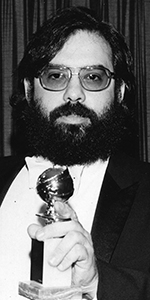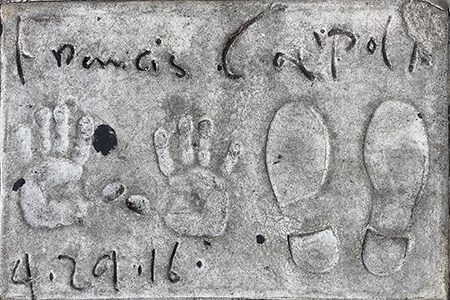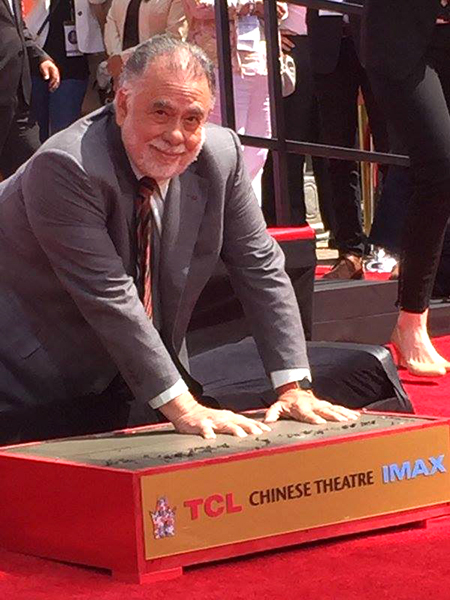 |
 |
 |
 |
 |
| Francis Ford Coppola backstage at the 31st Golden Globe Awards at the Cocoanut Grove, Ambassador Hotel, Los Angeles, California, January 26, 1974. |
| |
|
| |
|
 |
| |
 |
| |
 |
| |
 |
| |
 |
| |
 |
| |
|
|
| Francis Ford Coppola
|
 |
Forecourt Ceremony held on Friday, April 29, 2016
|
| |
Born: April 7, 1939, in Detroit, Michigan
Age at the time of the ceremony: 77 |
| |
Francis Ford Coppola is the dean of American filmmakers. Mentor to George Lucas, Steven Speilberg, Paul Schrader, Martin Scorsese, Terrence Malik, Godfrey Reggio and John Milius, Coppola is a huge risk taker and superb storyteller; as creator of the Godfather films and Apocalypse Now, Coppola's place in cinema history is beyond question.
Francis Ford Coppola was born to flautist Carmine Coppola and homemaker Italia Coppola. Francis is the middle child; his older brother August is the father of Nicolas Cage; his younger sister is actor Talia Shire. When Francis was two, the family moved to New York, where Carmine took the job as principal flautist in the NBC Symphony Orchestra. The family lived in Woodside, Queens.
A sickly child, young Francis began making home-made films at an early age. He recalls seeing A Streetcar Named Desire at the age of 15, and deciding that he would concentrate on becoming a filmmaker. After graduating from Great Neck High School, he entered Hosftra Collage in 1955 as a theatre arts major, where a classmate was James Caan.
Coppola was a very active student, staging a great number of plays. He also directed a short film called No Cigar (which has never been released). One of his professors was the pioneering director Dorothy Arzner, whose encouragement Coppola found pivotal. He graduated from Hostra in 1960.
Coppola attended the UCLA Film School, and made some short films dealing with the supernatural. A production company hired Coppola to re-cut a German film for the US market; the result became The Bellboy and the Playgirls (released in February 1962) with June Wilkinson. By this time, Coppola was working for producer Roger Corman, who gave the young man an opportunity to make a film. Coppola wrote a story in one day, and shot the film on a $40,00 budget in nine days. Demenia 13 (released in September 1963) with William Campbell, made back its money. It was here that Coppola met and married Eleanor Jessie Neil, who would accompany him on many film adventures.
Landing a writing gig at Seven Arts, Coppola wrote the scripts for several films, but bought the rights to the novel You're a Big Boy Now (released in December 1966), filming it with Elizabeth Hartman; the film became his master thesis at UCLA, where he graduated with an MFA in 1967.
Warner Bros., always looking for what "the kids" would buy, assigned Coppola to direct the musical Finian's Rainbow (released in October 1968) with Fred Astaire. His assistant on the picture was a young man named George Lucas, who had won a contest to work on the picture. Lucas would be a production assistant on Coppola's low-budget project The Rain People (released in August 1969) with James Caan. Lucas did a documentary on the film's production called The Making of "The Rain People" (released in August 1969).
Coppola was hired to write the script for
Patton (released in April 1970) with George C. Scott, and while he turned it in, another writer re-wrote it (leaving in the famous opening scene at Scott's insistence). Coppola and the other writer got the Oscar for writing.
Coppola and Lucas opened their American Zoetrope studio in San Francisco and made their first picture THX 1138 (released by Warner Bros. in March 1971), with Robert Duvall. While the film flopped, it has since become a classic.
Classic status has also been accorded Coppola's breackout hit The Godfather (released in March 1972) with Marlon Brando. Hired to bring an honesty and truth to the picture, Coppola directed and co-wrote the script and succeeded beyond anyone's expectation, including winning the Oscar for Best Picture and Adapted Screenplay. A monster hit, Coppola was now in a position to act as executive producer on George Lucas' film American Graffiti (released in August 1973) with Richard Dreyfuss. Another big hit.
The Conversation (released in April 1974) with Gene Hackman, won the Palm d'Or at the Cannes Film Festival, but did tepid business stateside. But that was OK with Paramount, who wrote Coppola a very large check to make The Godfather: Part II (released in December 1974) with Al Pacino. It performed very well and many consider Part II to be superior to the first film. It won the Oscar for Best Picture and Adapted Screenplay, with Coppola winning the Best Director Oscar for this one. Around this time, Coppola began purchasing vineyards in Napa, California.
With this kind of success under him, Coppola went to the Philippines to make Apocalypse Now (released in August 1979) with Marlon Brando. The notoriously delayed film won the Palm d'Or at Cannes, and became a flashpoint with audiences, who showed up in droves to see what Coppola had wrought.
Coppola next made the musical fantasy
One from the Heart (which played the Chinese in January 1982) with Frederic Forrest. The expensive film flopped. Filming two S.E. Hinton novels The Outsiders (released in March 1983) with C. Thomas Howell and Rumble Fish (released in October 1983) with Matt Dillon, put Coppola back on the map, but his overseeing of the problem-plagued The Cotton Club (released in December 1984) with Richard Gere, put Coppola in a tailspin.
Coppola directed Captain EO (opened in September 1986 in specially constructed theatres at Disneyland parks) which was a 17 minute 3D musical, written by George Lucas and starring Michael Jackson.
He directed the comedy Peggy Sue Got Married (released in October 1986) with Kathleen Turner, which did well, while his film Tucker: The Man and His Dream (which played the Chinese in August 1988) with Jeff Bridges in the title role, did only so-so. Paramount greenmailed Coppola into making The Godfather: Part III (which played the Chinese in December 1990) once more with Al Pacino.
Coppola produced and directed Bram Stoker's Dracula (released in November 1992) with Gary Oldman, which became a big hit. His directing of the John Grisham novel The Rainmaker (released in November 1997) with Matt Damon, fared well.
Coppola spent the next few
years acquiring more vineyards in Napa, and selling his "Coppola" brand of wine, as well as ressurecting the Ingelnook brand. All of this is now called The Family Coppola, a winery, restaurant, bar, vacation destination just south of Geyserville. It looks nice — why not visit?
People have not really attended the last few Coppola movies, but the man keeps working on 'em:
Youth Without Youth (released in October 2007) with Tim Roth, Tetro (released in May 2009) with Vincent Gallo, Twixt (released in September 2011) with Val Kilmer, and Distant Vision (released in July 2016) with Alexander Niles.
Coppola was invited to make his imprints at the Chinese during the 2016 Turner Classic Film Festival. His Footprint ceremony was followed by a screening of The Conversation.
Paramount gave Coppola a chance to completely re-work the third installment of the Godfather series, which was released as The Godfather Coda: The Death of Michael Corleone (released in December 2020). Is it any better? You decide.
And while you are at it, you cn figure out Coppola's Passion project Megalopolis with Adam Driver, which premiered at Cannes in May 2024. Looking for a U.S. distributor. Anyone? Lionsgate stepped up for the U.S., releasing the film with all the trimmings (it played the Chinese in September 2024).
| |
|
|
|
| |
 |
 |
| TCL Chinese Theatre IMAX®, Hollywood, California. Francis Ford Coppola Forecourt block. Executed by unknown, Friday, April 29, 2016. 30 x 20 inches. |
 |
 |
 |
| TCL Chinese Theatre IMAX®, Hollywood, California. Francis Ford Coppola Forecourt ceremony, Friday, April 29, 2016. Francis Coppola looks up at the cameras while placing his hands in the wet cement. |
|
|